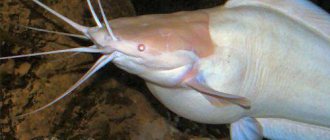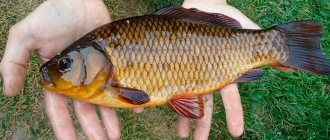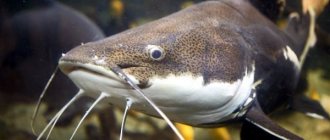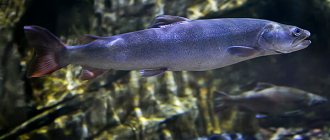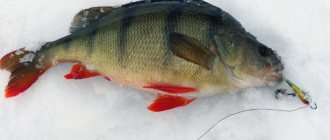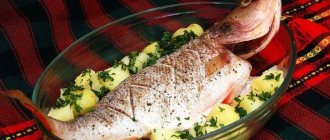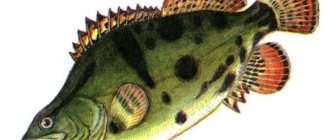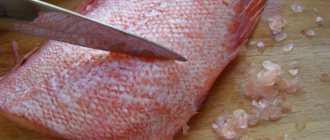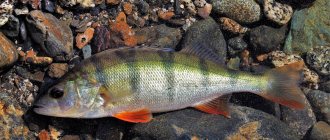A frequent trophy among fishing enthusiasts, especially in winter, is river perch. A large perch is the most desirable prey, and having caught this fish, you want to immediately weigh it, measure it and photograph it.
This article will talk about this wonderful fish and how the weight and size of a perch relate to its age. You can also find out where the largest perch in the world was caught.
Perch: habitat
River perch is one of the most well-studied and widespread fish species in Eurasia. And yet, in reality, there are many more questions in terms of perch biology than answers. It turns out that other fish species have been studied even less well.
River perch lives almost throughout Eurasia. In Asia, it is found even in the north (Kolyma), and was once distinguished as a separate subspecies. In the south, on Lake Balkhash, this species is adjacent to the Balkhash perch.
In Europe, its habitat first extended to the northern part of the British Isles, the northern parts of the Scandinavian Peninsula and the north of the Kola Peninsula. The southern range covered the territories of almost all of Europe. But now the places where this fish is found are expanding, since river perch, being a competitive species, often displaces local endemic representatives when introduced into new bodies of water.
Today the perch is found in the north of Ireland and Britain, sometimes in Iran, Turkey, China and even Africa. They were able to acclimatize him in both Australia and New Zealand. Only in the United States did this fish not take root due to its displacement by the local species of yellow perch, which is very similar to the river one.
The largest river perch lived on the Nile River. You can find out a little more about this below.
River perch - Perca fluviatilis
| CLASSIFICATION | |
| Class: | Ray-finned fish |
| Squad: | Perciformes |
| Family: | Perch |
| Genus: | Freshwater groupers |
| View: | River perch |
External structure of river perch: River perch is a typical representative of the perch family, and is considered a predatory fish. This species lives in fresh water bodies of Europe and Northern Asia, where it is the main object of sport fishing. Also introduced to countries such as New Zealand, Australia and Africa. Where it took root and became the main fish of some reservoirs.
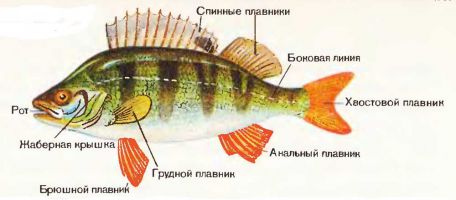
The body of the perch is flattened laterally and has a greenish-yellow tint. It is covered with small but strong scales, which have small jagged edges, and can be easily compared to sandpaper. There are dark transverse stripes on the body for which some fishermen call it (minke, sailor). These stripes, in addition to the green-yellow tint, create a kind of camouflage that camouflages it well among aquatic vegetation.
The perch's mouth can open quite wide, which it uses when hunting fairly large fish. The lips are quite thin and often tear when bitten. Therefore, after hooking, the perch must be pulled out smoothly, without sudden jerks.
Another feature of the perch (and all fish of the perch family) is its dorsal fin. The fin rays are quite hard and pointed. And he can easily injure the fisherman’s hand with them. On the back of the first dorsal fin there is a dark spot, which, of all the fish of the perch family, is found only in the river perch.
Description
Perch has excellent ecological plasticity, and therefore, adapting to different living conditions, it can look completely different. For example, in Karelian lakes you can find almost black representatives of the species. This coloring allows them to camouflage well. And in many rivers where the sandy bottom predominates, this fish, on the contrary, is very light. Sometimes even the stripes on her body are not visible.
The sizes, proportions, number and color of fins can also vary. It is important to note that all of these existing forms are not subspecies. Their external features are not inherited, and over time, for example, a dark-colored Karelian perch placed in a reservoir with a lighter bottom gradually becomes lighter.
The largest perch in Russia is considered to weigh just under 6 kilograms, but this is quite rare. Even weighing about 1.5 kg, this fish is considered large, and more than two kilograms is considered very large. In small bodies of water, the average weight of perches rarely reaches 700-1200 grams.
The big bass aren't that big. For the most part they grow in height and thickness. Their length is approximately 54 cm, and their thickness and height are approximately 18 and 27 centimeters, respectively.
Habitats
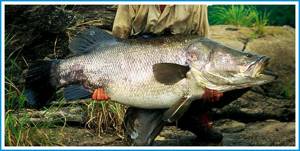
This giant fish lives both in the wild and is artificially bred in reservoirs of fish farms.
wild nature
Nile perch is distributed mainly in freshwater bodies of the African continent, for example, in the Nile, Congo, Volta, and Senegal rivers. It is also often found in lakes Chad, Victoria, Albert and so on.
Artificial reservoirs
Nile perch is actively bred in artificial reservoirs, although here individuals are somewhat smaller in size than their counterparts living in the wild. Artificial reservoirs where this fish is bred can now be found all over the world, since Nile perch meat is highly valued in industrial production.
Russian perch
The usual size of perch does not exceed 1200 grams. In rare cases, it reaches 2.8 kg, and only in large lakes, for example, on Onega, are there 3-kilogram or more, and on Lake Peipus - 4-kg. It should be noted that such giants are no longer a curiosity for Western Siberia. Yekaterinburg lakes and reservoirs in its environs are home to huge perches (about 5 kg).
The largest perch caught in Russia is a female spawn, whose weight reached 5.965 kilograms. It was caught on Lake Tishkin Sor in 1996, in the Tyumen region (Uvat district).
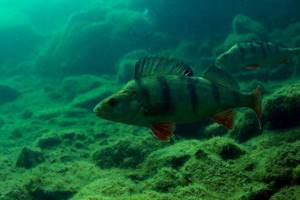
Particularly large perches are caught in Siberia and the Lower Volga. This is due to the presence of large feeding grounds and the slight pressure of civilization.
The age of the fish is determined by the growth rings marked on the upper jaw and on the operculum bone. River perch can live up to about 23 years. This age was recorded for perch that lived and was caught in Mongolia, in Lake Khuvsgol. Its length was 44.7 cm, and its body weight was more than 2 kg.
Both the size and lifespan of fish of this species also depend on the characteristics of the reservoir. Where does large perch live in Russia? The largest specimen can be found in the deltas of the Kuban and Volga rivers and in the reservoirs of Siberia.
Types of perch
In many large bodies of water, the perch population is represented by two races, each of which has its own unique habitats, diet and behavior. In the bays, in the coastal thickets, the so-called grass perch lives, and there is quite a lot of it, but it grows slowly. This specimen feeds mostly on invertebrates, but is often itself a victim of predators. Usually he is caught while fishing with a float rod.
The characteristics of deep-seated perch can be described as follows: it grows quickly, has a thick and wide body, and feeds mainly on small fish.
A characteristic feature for representatives of both races is that at a certain stage they occupy approximately the same habitat and lead a similar lifestyle. Changes and differences occur as we grow older. It should be noted that among the deep race the proportion of females is much higher. This is due to the fact that fast-growing females spawn annually.
Regarding the grass form, some researchers believe that an insufficient food supply for them definitely inhibits both their growth and the development of eggs, and therefore representatives of this species spawn only after a year.
Nile perch
Nile perch is the largest perch in the world. This individual reaches a length of up to two meters, and its weight can exceed 150 kilograms.
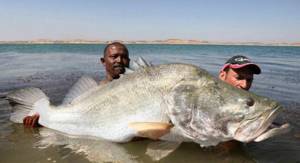
Due to its gigantic size, this perch is the most important predator in any habitat. It is found mainly in rivers such as the Nile, Niger and Congo.
It was in the 50s of the 19th century that Nile perch was an important commercial species. It was introduced to the lakes of East Africa - Victoria and Tanganyika.
In addition, this species was introduced into the artificial Lake Nasser, where it was bred as a commercial fish. This kind of perch is a favorite catch among sports fishermen. Due to its unusually large size and ferocious disposition, it is a desirable trophy for any fisherman. A photo of the largest perch is presented below.
Nile perch usually feeds on other fish species, crayfish, and insects. There are cases of eating small representatives of their own species. The voracious perch happily bites on artificial feeding and bait.
Fishermen from all over the world come to the rivers and lakes of Africa with one single goal - to catch this magnificent giant representative. And the meat of this fish is very tasty.

It should also be noted that in 2002, an angler from Great Britain was able to catch the world's largest Nile perch, which weighed about 85 kilograms. In addition, a naturally dead perch (the largest) was once caught on Lake Victoria, the weight of which reached 140 kilograms. And ichthyologists say that this is not the limit.
Where does it live and what does it eat?
This breed of fish loves warm water, so it is found in the tropical zones of the Indian and Pacific oceans. The most common habitats are the coasts of Africa, Australia and Japan. The giant grouper also loves the shores of the Caribbean Sea, where quite large individuals are often found.
Does not welcome greater depth. Guasa lives at a depth of no more than one hundred meters, so it becomes easy prey for poachers.
The grouper's behavior is to hide in reefs, rocks, and possibly in sunken ships. If a grouper is caught swimming, then it probably swam to do its own business, otherwise it would not have come out of its hiding place. He's so uncommunicative. Although he does the right thing, because he has become a very valuable prey for poachers.
As already mentioned, this type of perch eats everything that falls into its mouth. Sometimes these are even small sharks and rays. It sucks in the prey and immediately swallows it. Hunts while sitting in a shelter by tracking its prey. If the prey has passed the so-called face control, then it freely goes straight into his stomach.
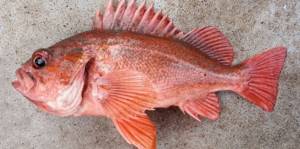
Reproduction occurs using eggs. Rockfish lay them mainly in coral reefs. Subsequently, for grouper fry, this place is both a source of food and suitable as a refuge.
A little about spawning
An increase in temperature to 10 degrees and melting ice is a good incentive for perch to spawn. Such conditions are necessary for the complete maturation of eggs, since it depends on the presence of nutrition and oxygen in the water.

Spawning migrations are a typical but not obligatory phenomenon. For example, perch that lives in fresh water, as a rule, simply looks for well-warmed and shallow areas. But individuals living in slightly salted water bodies go to fresh river water to spawn, because their eggs are sensitive to salt (they die in a salty solution as a result of dehydration).
Perch spawning lasts about a week. The number of eggs in large females can reach up to 300,000, although on average their number is about 20-30 thousand.
Kinds
In total, there are about a hundred species of perch, divided into nine genera. All types of perches have different habitats, their own characteristic appearance and behavioral features.
Let's look at what kinds of perches there are, namely the most famous types:
- river;
- lake;
- nautical;
- yellow;
- Balkhash;
- Nile;
- largemouth;
- firebrand.
River
The territory where perch lives is the fresh waters of European countries, as well as reservoirs of northern Asia. It feeds on small freshwater fish. River has high variability within the species. The appearance of the fish depends on where it lives, as well as environmental conditions. Currently, there are no subspecies of this perch. Yellow perch, previously considered a subspecies of the river one, is now identified as an independent variety. The river species is divided into several forms. Types of perch differ in their places of residence, growth rate, size, and type of food.
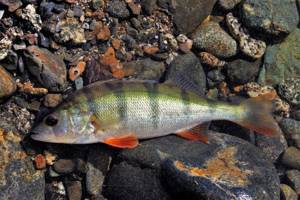
Herbalist
“Grass” or “coastal” is the name given to the slow-growing form of the species. The perch lives in shallow water in the algae of the coastal zone. The basis of the herbalist's diet: small bugs, worms and other insects. It grows very slowly, so this perch is always small. The maximum parameters are 15 centimeters in length with a weight of no more than 70 grams. The herbaceous plant is lighter in color and its body is more elongated.
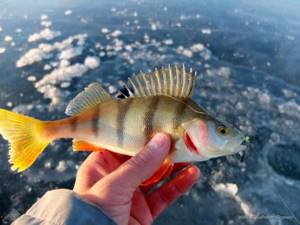
Ozernoy
Lake perch is the largest of all species. It is distributed in forest lakes. The largest fish can be found in western Siberia; their weight can be about 5 kilograms. It differs from the river species in color. The river one is darker than the lake one. Since this species is freshwater, its distribution areas are the same as that of the river species.
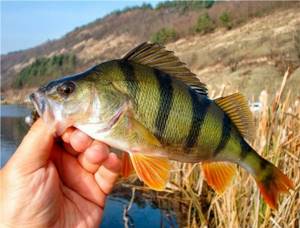
Humpback (humpback)
“Deep” is a large form of the species. Lives at the depths of the reservoir, stays away from the shores. Having reached medium size, the predator begins to consume more and more of its own kind. Subsequently, it will form the basis of his diet. The deep subspecies grows much faster than the coastal subspecies. Individuals can grow up to 55 cm in length with a weight of up to 4.5 kg. The growth rate of fish depends entirely on the condition of the habitat. The cleaner the reservoir, the faster the predator develops. In five years, the humpback can grow up to 30 cm.
The typical hump is clearly visible behind the head of large individuals, which is why they are often called “humpbacks.” The back of the “humpback” has a distinctive black color, for which it is also called “black-backed”. The scales of the perch are a bright greenish-olive shade. The beautiful appearance and size of the “humpback” will not allow it to be confused with its “grass” counterpart. At first these races live together, then their paths separate.
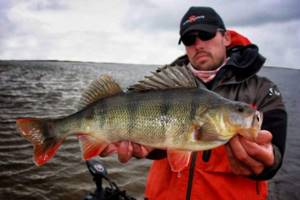
Yellow
Externally, this species is very similar to the common perch. Distinctive features: yellow color and large size. Yellow perch are larger than most other species. These cold-loving fish inhabit fresh water bodies in northern America. The species is unofficially called “American”.
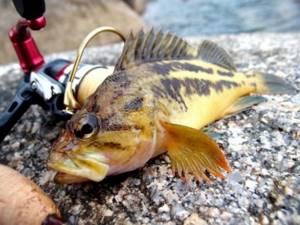
Bighead (firebrand)
The official name of the species is rotan. Outwardly it looks more like a bull, which can be seen in the photo. It is distinguished by the presence of two fins on the back near the head. The color of the scales ranges from gray with a green tint, in rare cases it is painted black. Light stripes or spots may be visible across the body. "Loveshka" lives in fresh waters. Rotan is often found in the Amur River: this is where it began to spread throughout Europe. One of the names of the fish is “Amur goby.”
The lifespan of rotan is five years. This fish grows up to a maximum of 23 cm in length. The firebrand feeds on small fish, leeches and larvae. Rotan is very unpretentious and omnivorous: this predator is able to survive in all natural conditions. The appearance of rotan in a reservoir leads to a decrease in the number of carp and crucian carp. Therefore, it was previously believed that rotans exterminate other species. But, devouring the fry of crucian carp and crucian carp, this predator thins out their numbers. This allows surviving individuals to reach larger sizes. The benefits for nature from rotan are obvious, despite different opinions. Interesting fact: although rotan is called “perch-head”, it does not belong to the perch family. Its ancestors are Odontobutaceae, genus Firebrand.
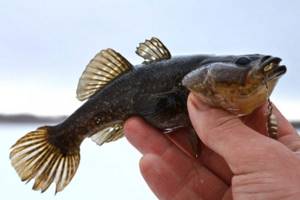
Balkhash
Found in Lake Balkhash and Alakol lakes. Differs in paler color. The color of the scales varies from light gray to darker. The fins are gray, there is no black spot. Adults do not have vertical stripes. The lower jaw is extended forward. This gives it a resemblance to pike perch. Now the number of the species has decreased due to the aggressive behavior of pike perch, which eats young fish.
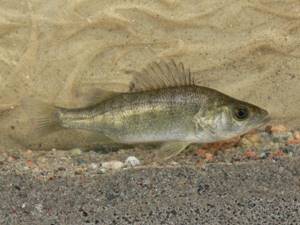
Redfin
Redfin perches are called redfish due to one distinctive external feature - the color of their fins. The ventral, anal and caudal fins are characteristically colored in shades of red. The special striped color combined with bright fins gives the fish a very beautiful appearance. During spawning, the individual acquires a brighter color.
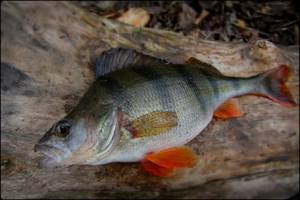
About the habits of fish
At its core, perch is a schooling fish. Only the largest individuals stay solitary. Juveniles usually form large flocks of up to 100 individuals or more. Young fish feed on the eggs of other fish and invertebrates. Therefore, it is not the number of them in the flock that is important, but a good place.

Teenage perches stay in schools of about 5-20, since in such a group it is easier to hunt fry, crowding them together and creating a kind of cauldron in which predators quickly lose self-control from the sight of a large amount of prey and begin to attack aggressively. The “cauldron” for spinning fishing is the most convenient option, but the chances of catching a large specimen are slim.
Lifestyle
A significant portion of the diet of adult perch is occupied by other freshwater fish. Perch will eat any fish, as long as it is the right size. And since its toothy mouth is very wide, it can eat quite large fish. Even juvenile perch prey on fry of other fish almost the same size as the perch themselves. Perches do not give mercy even to their own offspring. In addition to fish, perches also hunt crayfish (especially molting crayfish, lacking a durable shell, although they can handle crustaceans protected by a shell), caviar, and aquatic insects.
Perch is unusually voracious. If there is a large school of fish in front of him, he, having barely swallowed one fish, immediately swallows the second, third, etc. Sometimes fry that do not fit in the stomach stick out of the mouth. Many believe that the greatest damage to the “fish stock” is caused by pike. However, in this regard, the perch is unlikely to yield to it, rather the opposite. In ponds where pike perch, bream, whitefish, and especially carp are bred, perch is a death sentence for caviar and fry.
The predatory perch, however, often becomes the prey of larger predators - pike, catfish, burbot, pike perch, as well as birds - gulls, osprey, hawks, etc.
Spawning of perch begins in the south of the country in March - April, and in the north - in May, and sometimes it drags on, and individual specimens are caught with milk even in June. During spawning it does not gather in large flocks. The eggs are usually laid near last year's aquatic vegetation, at shallow depths. After spawning, it goes to summer camps, where it stays relatively sedentary until autumn. With the onset of cold weather, it gradually gathers in large flocks and lives in the middle and lower layers of water. Small perch feed on various aquatic insects, and as they grow, they become predators.
